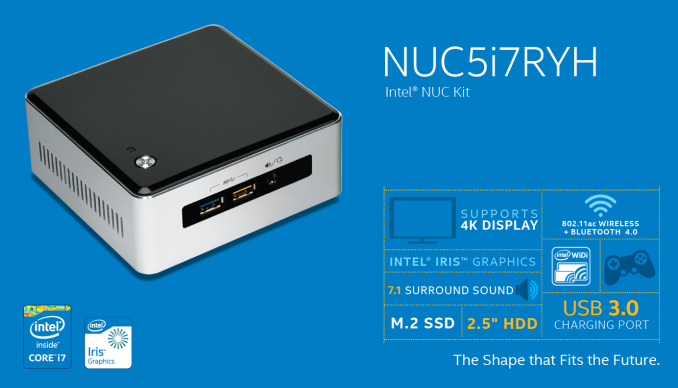Intel NUC5i7RYH Broadwell-U Iris NUC Review
by Ganesh T S on April 20, 2015 8:00 AM EST- Posted in
- Systems
- Intel
- HTPC
- NUC
- Broadwell-U
Final Words
The Intel NUC5i7RYH provided us with the opportunity to take a look at what a higher TDP CPU and Iris Graphics can bring to the table in the UCFF space. Intel is pitching the Iris NUC as a gaming and content creation solution. Based on our evaluation, the Iris NUC seems to provide the best performance per watt in this form factor. The BRIX Pro with the Core i7-4770R is a better all-round solution, but that comes with bad acoustics and higher power consumption. It is also slightly bigger in order to accommodate the necessary thermal solution. The Iris NUC doesn't suffer from those drawbacks, thanks to the use of a 28W TDP CPU in the system.
In terms of scope for improvement, we would like to see a full-sized HDMI port in the back panel. The BRIX PCs are able to accommodate full-sized HDMI ports, so there is really nothing on the technical side to prevent this. If a mini-HDMI port is non-negotiable, it would be good to have either a mini-HDMI to full-sized HDMI adapter or a mini-HDMI to HDMI cable in the package. The design for accommodating the 2.5" drive is better than what we saw in the Haswell NUC. However, the cabling and 2.5" drive slot in the BRIX H series is definitely better. Other improvement aspects that we suggested in the Broadwell-U NUC review are applicable here also.
Minor quibbles aside, the Iris NUC delivers what it promises - decent casual gaming credentials and optimal CPU performance while ensuring that acoustics and power consumption remain reasonable. In fact, it has the best performance amongst all the traditional UCFF PCs that we have evaluated so far.
The final aspect that we talk about today is pricing. The NUC5i7RYH seems to be available on pre-order for $480 on CDW (even though Intel indicated a street price of $500). M.2 SSDs (both NVMe and SATA AHCI) continue to carry a premium. For users wishing to keep the build cost down, the Iris NUC also supports a traditional 2.5" drive. This makes the Iris NUC mini-PC an excellent choice for all budgets.











66 Comments
View All Comments
ShieTar - Monday, April 20, 2015 - link
Depends on what you mean with "the M.2 spec". I have a XP941 on a MSI Z97 Board, its measurably faster than the 840Pro I came from.I figure in this case the problem should be with the NUC board rather than the interface spec. The Plextor itself is not fast enough to profit from the interface, but it should be fast enough to work without noticable stuttering.
nutternatter34 - Tuesday, April 21, 2015 - link
In my case we're talking about an X99 board, and an Intel 530 series M.2 drive (180gb). I compared that to each SSD I own. An Intel 320 series, a Samsung 830 series and the Crucial MX100 series. (120gb/256gb/512gb). M.2 was a disaster, what's worse there's barely anything to configure, it should just work.meacupla - Monday, April 20, 2015 - link
Oh, so this is limited to 45W?I wonder what the 3rd party makers could do with this chip if they expanded the power envelope and cooling capabilities.
Qwertilot - Monday, April 20, 2015 - link
28w for the CPU/GPU, 17 for the rest even ;)I guess we'll find out what is possible when Broadwell K finally makes its much delayed appearance....
charea - Monday, April 20, 2015 - link
So why use a 65W brick for a system limited at 45W? It doesn't make sense.close - Monday, April 20, 2015 - link
If you're going to power some more devices from the system then it helps to have a power source that's slightly oversized.charea - Monday, April 20, 2015 - link
Are you saying that the monitor is excluded from this limit? Was the test done without a screen included?dave_the_nerd - Monday, April 20, 2015 - link
USB devices pull up to 5w each. The test doesn't include a monitor. 30-40w draw for a 24" monitor is typical.ganeshts - Monday, April 20, 2015 - link
Right - 4x USB 3.0 ports need 20W. Add that to the 45W, and you are already at the 65W limit.Our stress test only loads up the CPU and GPU - it doesn't even do the internal storage stressing or WLAN stressing - these are bound to increase the power consumption a bit. That said, stressing those might actually result in the CPU not getting loaded as much as it does in our Prime 95 test.
ShieTar - Monday, April 20, 2015 - link
And thats nicely keeping to the spec, there are ports and charger cables out there working with 2A => 10W.